 Elvas - Portugal
Elvas - Portugal
Hello everyone, I hope you are doing well 🙂 Today I want to show you a little about my vacation here in Elvas. These holidays are more about relaxing a little, enjoying the pool and the good weather to sunbathe
Right now I'm in the shade of a tree writing this post for you, if there's one thing I like it's writing in the middle of nature for you 🙂 I love telling you the things I visit!

I've tried to talk to European women on Hive and Steemit so far, but mostly without success!
I guessed that it was because my awkward English as an East Asian man was not very attractive to European women!😅
But, @name0 is the only European woman who has ever been friends with an East Asian man like me!😄
@name0 is a young Portuguese woman who currently works as a kindergarten teacher!
I guessed @name0 would be very strong and patient! Because the work of kindergarten teachers is very hard!
@name0 mainly writes articles about her travels in various regions of Portugal.
East Asia, where I live, and Portugal, where @name0 lives, are on opposite sides of the globe. We live at the ends of the East and the West and talk to each other.
So, We don't know much about each other's worlds that we live in!
I asked her a lot of questions because I didn't know much about Portugal, and she answered kindly.
I wanted to tell @name0 about the views that East Asian men like me have on Portuguese women!
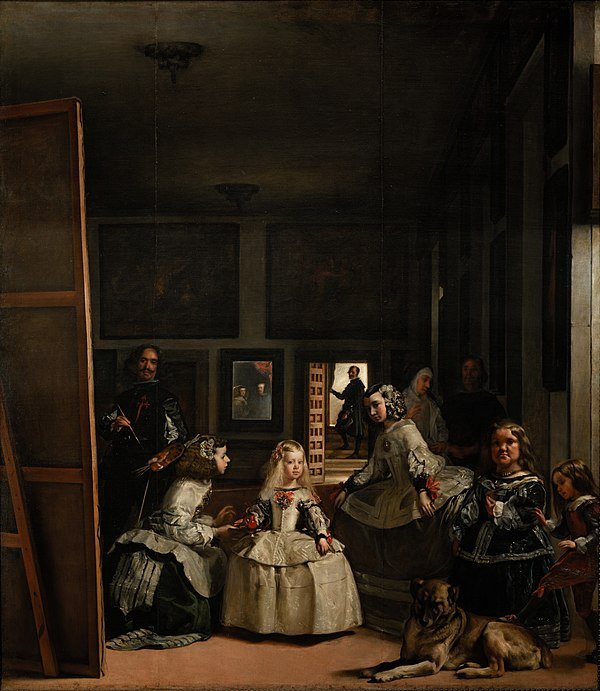 Las Meninas
Las Meninas
Las Meninas (Spanish for 'The Ladies-in-waiting'[a] pronounced [las meˈninas]) is a 1656 painting in the Museo del Prado in Madrid, by Diego Velázquez, the leading artist of the Spanish Baroque. It has become one of the most widely analyzed works in Western painting for the way its complex and enigmatic composition raises questions about reality and illusion, and for the uncertain relationship it creates between the viewer and the figures depicted.
The painting is believed by F. J. Sánchez Cantón to depict a room in the Royal Alcazar of Madrid during the reign of King Philip IV of Spain, and presents several figures, most identifiable from the Spanish court, captured in a particular moment as if in a snapshot.[b][2] Some of the figures look out of the canvas towards the viewer, while others interact among themselves. The five-year-old Infanta Margaret Theresa is surrounded by her entourage of maids of honour, chaperone, bodyguard, two dwarfs and a dog. Just behind them, Velázquez portrays himself working at a large canvas. Velázquez looks outwards beyond the pictorial space to where a viewer of the painting would stand.[3] In the background there is a mirror that reflects the upper bodies of the king and queen. They appear to be placed outside the picture space in a position similar to that of the viewer, although some scholars have speculated that their image is a reflection from the painting Velázquez is shown working on.
Las Meninas has long been recognised as one of the most important paintings in the history of Western art. The Baroque painter Luca Giordano said that it represents the "theology of painting", and in 1827 the president of the Royal Academy of Arts Sir Thomas Lawrence described the work in a letter to his successor David Wilkie as "the true philosophy of the art".[4] More recently, it has been described as "Velázquez's supreme achievement, a highly self-conscious, calculated demonstration of what painting could achieve, and perhaps the most searching comment ever made on the possibilities of the easel painting".[5]
However, since I don't know anything about Portugal, I ended up expressing the charm of Portuguese women with a famous Spanish painting. I hope @name0 understands that first!😂
I hope you understand that for ordinary East Asian men like me, it's hard to tell the difference between Portugal and Spain!
So,
So I would call Portuguese and Spanish women the women of the Iberian Peninsula!
las meˈninas is a famous work that symbolizes the charm of women in the Iberian Peninsula!
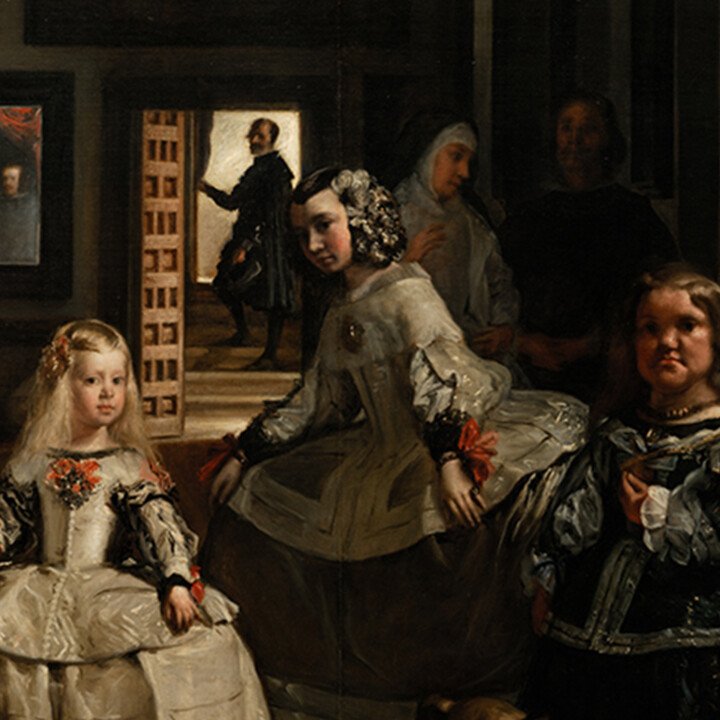
Doña Margarita María of Austria stands in the center like the main character of the work, with maids on her left and right.
However, Doña Margarita María of Austria is not very pretty!
To the left of Doña Margarita María of Austria is the stunningly beautiful Doña Isabel de Velasco!
From my perspective as an East Asian male, Doña Isabel de Velasco is very beautiful!
I guessed that Doña Isabel de Velasco was the most beautiful woman in the court!
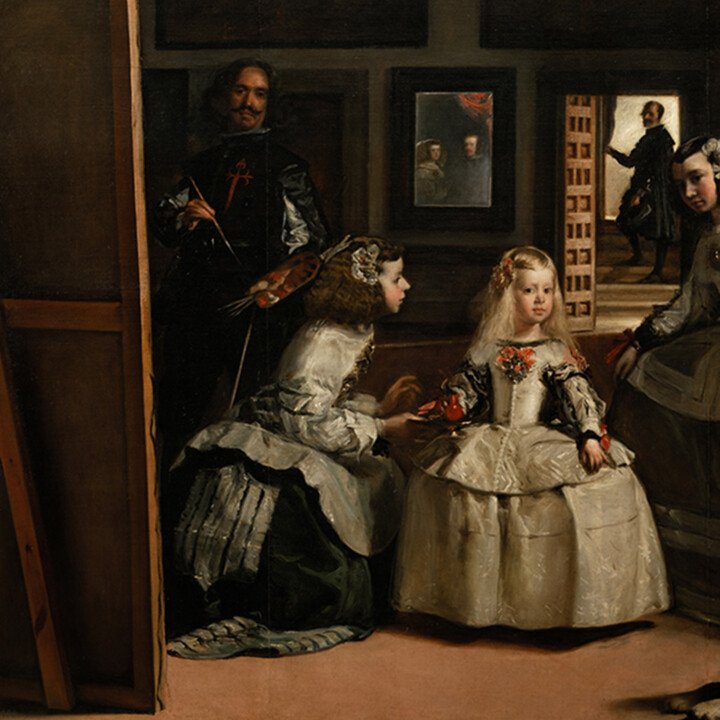
Also beautiful is Doña Maria Augustina de Sarmiento, kneeling to the right of Doña Margarita Maria of Austria!
From an East Asian perspective like mine, it's shocking that maids are more beautiful than princesses!
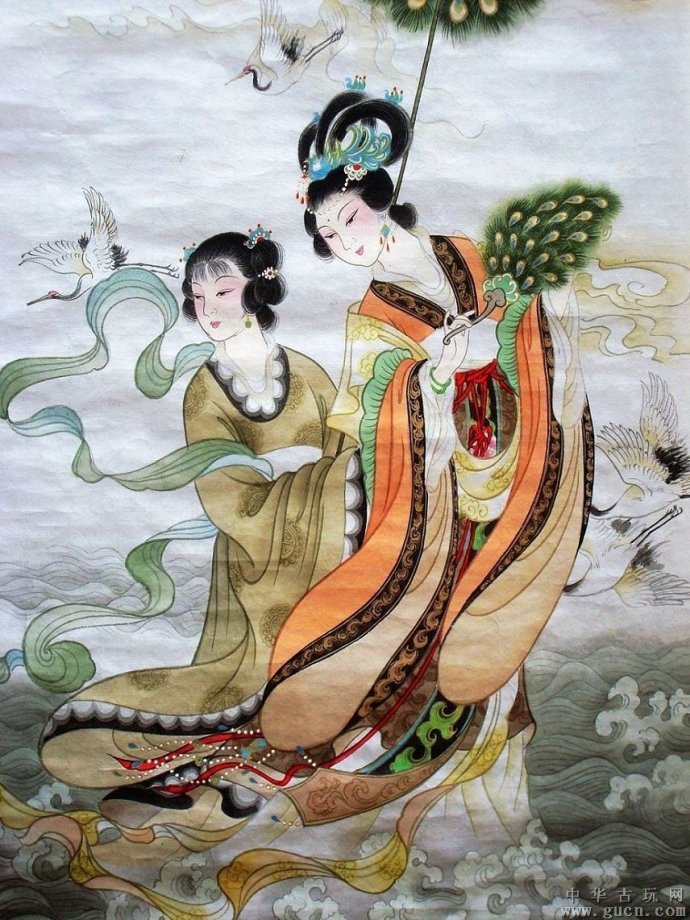

In East Asian cultural practices, upper-class women are always depicted as more beautiful than their maids.
So, the paintings of the princesses and their maids from Las Meˈninas had a great cultural impact on East Asian men.
The dress of the court ladies of Las Meˈninas was very heavy and ornate, revealing Catholic asceticism! I guessed that their clothes must have been uncomfortable to live in!
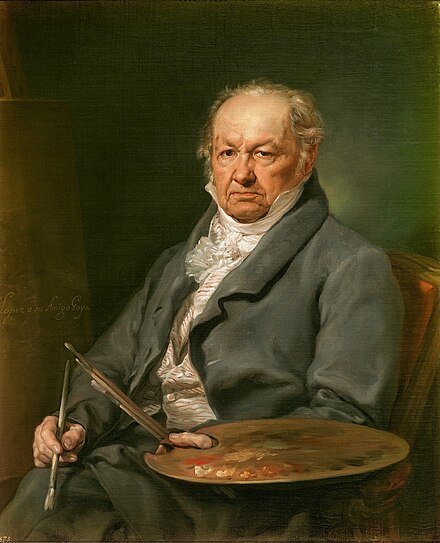 Portrait of Goya by Vicente López (1826), Museo del Prado, Madrid
Portrait of Goya by Vicente López (1826), Museo del Prado, Madrid
Francisco José de Goya y Lucientes (/ˈɡɔɪə/; Spanish: [fɾanˈθisko xoˈse ðe ˈɣoʝa i luˈθjentes]; 30 March 1746 – 16 April 1828) was a Spanish romantic painter and printmaker. He is considered the most important Spanish artist of the late 18th and early 19th centuries.[1] His paintings, drawings, and engravings reflected contemporary historical upheavals and influenced important 19th- and 20th-century painters.[2] Goya is often referred to as the last of the Old Masters and the first of the moderns.[3]
Goya was born to a middle-class family in 1746, in Fuendetodos in Aragon. He studied painting from age 14 under José Luzán y Martinez and moved to Madrid to study with Anton Raphael Mengs. He married Josefa Bayeu in 1773. Goya became a court painter to the Spanish Crown in 1786 and this early portion of his career is marked by portraits of the Spanish aristocracy and royalty, and Rococo-style tapestry cartoons designed for the royal palace.
Although Goya's letters and writings survive, little is known about his thoughts. He had a severe and undiagnosed illness in 1793 that left him deaf, after which his work became progressively darker and more pessimistic. His later easel and mural paintings, prints and drawings appear to reflect a bleak outlook on personal, social and political levels, and contrast with his social climbing. He was appointed Director of the Royal Academy in 1795, the year Manuel Godoy made an unfavorable treaty with France. In 1799, Goya became Primer Pintor de Cámara (Prime Court Painter), the highest rank for a Spanish court painter. In the late 1790s, commissioned by Godoy, he completed his La maja desnuda, a remarkably daring nude for the time and clearly indebted to Diego Velázquez. In 1800–01, he painted Charles IV of Spain and His Family, also influenced by Velázquez.
In 1807, Napoleon led the French army into the Peninsular War against Spain. Goya remained in Madrid during the war, which seems to have affected him deeply. Although he did not speak his thoughts in public, they can be inferred from his Disasters of War series of prints (although published 35 years after his death) and his 1814 paintings The Second of May 1808 and The Third of May 1808. Other works from his mid-period include the Caprichos and Los Disparates etching series, and a wide variety of paintings concerned with insanity, mental asylums, witches, fantastical creatures and religious and political corruption, all of which suggest that he feared for both his country's fate and his own mental and physical health.
His late period culminates with the Black Paintings of 1819–1823, applied on oil on the plaster walls of his house the Quinta del Sordo (House of the Deaf Man) where, disillusioned by political and social developments in Spain, he lived in near isolation. Goya eventually abandoned Spain in 1824 to retire to the French city of Bordeaux, accompanied by his much younger maid and companion, Leocadia Weiss, who may have been his lover. There he completed his La Tauromaquia series and a number of other works. Following a stroke that left him paralyzed on his right side, Goya died and was buried on 16 April 1828 aged 82.
The works of Francisco José de Goya y Lucientes portrayed the physical attractiveness of Iberian women in a most shocking way for modern East Asian men!
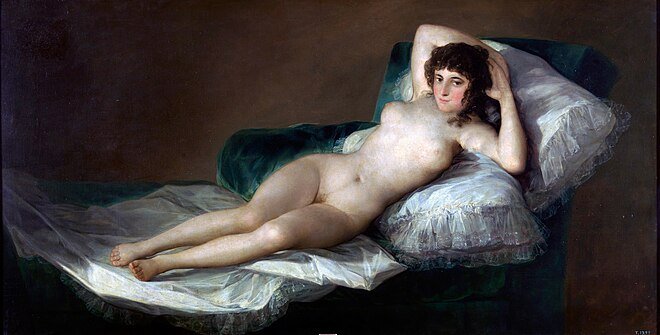 The Naked Maja
Spanish: La maja desnuda
The Naked Maja
Spanish: La maja desnuda
The Naked Maja or The Nude Maja[1] (Spanish: La maja desnuda [la ˈmaxa ðesˈnuða]) is an oil-on-canvas painting made around 1797–1800 by the Spanish artist Francisco de Goya, and is now in the Museo del Prado in Madrid. It portrays a nude woman reclining on a bed of pillows, and was probably commissioned by Manuel de Godoy, to hang in his private collection in a separate cabinet reserved for nude paintings. Goya created a pendant of the same woman identically posed, but clothed, known today as La maja vestida (The Clothed Maja), also in the Prado, and usually hung next to La maja desnuda. The subject is identified as a maja or fashionable lower-class Madrid woman, based on her costume in La maja vestida.
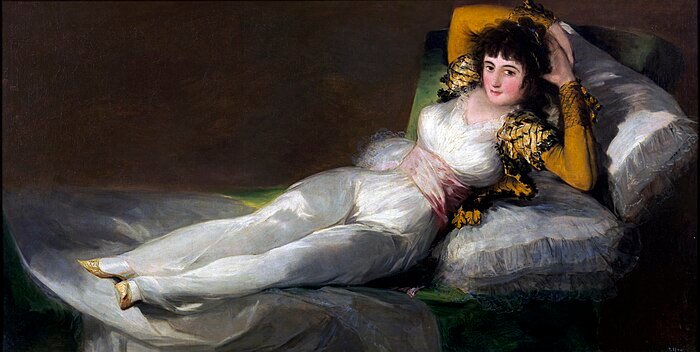 The Clothed Maja
Spanish: La maja vestida
The Clothed Maja
Spanish: La maja vestida
La maja vestida (English translation: The Clothed Maja) is an oil painting on canvas created between 1800 and 1807 by the Spanish Romantic painter and printmaker Francisco Goya. It is a clothed version of the earlier La maja desnuda, which was created between 1795 and 1800. The identity of the model and that of the commissioner have not been confirmed. However, art historians and scholars have suggested she is María Cayetana de Silva or Godoy's mistress Pepita Tudó.[1]
La Maja Desnuda (La maja desnuda) has been described as "the first totally profane life-size female nude in Western art" without pretense to allegorical or mythological meaning.[29] The identity of the Majas is uncertain. The most popularly cited models are the Duchess of Alba, with whom Goya was sometimes thought to have had an affair, and Pepita Tudó, mistress of Manuel de Godoy. Neither theory has been verified, and it remains as likely that the paintings represent an idealized composite.[30] The paintings were never publicly exhibited during Goya's lifetime and were owned by Godoy.[31] In 1808 all Godoy's property was seized by Ferdinand VII after his fall from power and exile, and in 1813 the Inquisition confiscated both works as 'obscene', returning them in 1836 to the Academy of Fine Arts of San Fernando.[32]
La Maja Desnuda (La maja desnuda) made East Asian men like me unforgettable with the sexual allure of Iberian women!
Francisco José de Goya y Lucientes' La Maja Desnuda (La maja desnuda) exposes the immorality and ugliness of the royal houses of 18th-century Europe.
Eighteenth-century European men, while outwardly boasting of Catholic piety and purity, actually had very obscene and decadent instincts.
From the perspective of modern East Asian men, the voluptuous bodies of Iberian women, which were different from those of East Asian women, were shocking!😅
The sight of Iberian women with provocative and sexual expressions that seduce men is unforgettable!

The general East Asian men rate Portuguese and Spanish women as having a different appeal from other European women because of their mixed Muslim and North African heritage.
There are rumors that women in the Iberian Peninsula have brown eyes and black hair, similar to Muslims.
I guessed that @name0 resembles the woman in the picture above!😄
I hope @name0 understands my awkward English!